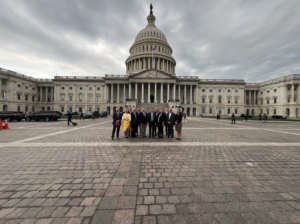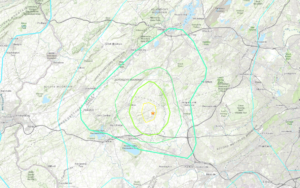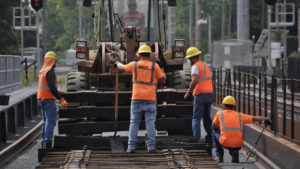Rail spur plan crosses hurdle; on to final design
Written by jroodA proposed 3.3-mile rail spur linking the Omya quarry on Foote Street in Middlebury, Vt., with the main line west of the Otter Creek can now proceed to final design and property acquisition, as the Federal Highway Administration has determined the estimated $34.3-million project could meet federal environmental standards, the Addison County Independent reports.
The FHWA’s 29-page
decision, issued earlier this month, specifically identifies a rail spur
alternative calling for an at-grade crossing of Halladay Road, bridge crossings
over Lower Foote Street and Creek Road, and an underpass for Route 7. The
project would call for around 2,050 feet of rail elevated on a trestle,
including a bridge spanning the Otter Creek.
The primary beneficiary of
the project would be Omya, which is seeking a rail alternative to move the
calcium carbonate it mines in Middlebury to its processing plant in Florence, a
task that currently requires many truck trips down Route 7 through downtown Brandon.
But the proposal also includes plans for a 2.2-acre transload facility in
Middlebury to enable other businesses to better access freight rail service.
State and local officials,
along with Vermont Railway and business leaders, have been studying the
feasibility of a rail spur for more than a decade. It’s a project that would
require public and corporate funding.
Federal and state officials
in November of 2008 released a final Environmental Impact Statement. The FHWA’s
record of decision affirms many of the findings in that environmental report
and sets the stage for more intensive planning of the rail spur and
negotiations with property owners whose land would be needed for the project,
or would be substantially affected by it.
Land acquisition and the
prospect of installing an at-grade crossing at Halladay Road loom as two of the
significant sticking points in efforts to move the rail spur forward.
The decision calls for the
town of Middlebury to petition for a "quiet zone signal" at the proposed
Halladay Road at-grade crossing to free approaching trains from the need to
sound horns or whistles. This is being pitched as a means of reducing noise
disturbances for area neighbors.
Middlebury Town Manager
Bill Finger was formerly the top administrator for the town of Shelburne. He
recalled how each "quiet zone" crossing cost $1,000,000 to construct in that
community.
"The railroad will not
support a quiet zone," Finger wrote in a recent memo to Middlebury selectmen.
Selectboard Chairman John
Tenny said he sees some merits in the at-grade crossing.
"It lowers the overall
impact and profile of the project, so I think it will have a lot less impact on
those residents and the landscape as a whole," Tenny said.
Mark Perrin and his family
own property off Creek Road that would be within the path, and view, of the
proposed rail spur. He is concerned about the impact the project would have on
his family’s land and wonders how the federal government will proceed with land
negotiations. Perrin noted some of the land needed for the plan is currently
locked up in state and local conservation easements.
"Some folks purchased their
property here knowing they were protected by (conservation restrictions),"
Perrin said.
Perrin said he hopes that
more information about the project and its funding sources will come to light
now that the FHWA has weighed in with its decision.
"I hope (project
organizers) will talk to the property owners and spell out who are the real
winners and losers in building this spur," Perrin said.
Middlebury Town Planner
Fred Dunnington said the FHWA decision is merely a "milestone" in a process
that is simply entering a new phase.
"It’s not over yet," Dunnington
said.





